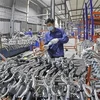 Production line of electric devices and components at Bluecom Vina Limited Company at Hai Phong City's Trang Due industrial park. (Photo: VNA)
Production line of electric devices and components at Bluecom Vina Limited Company at Hai Phong City's Trang Due industrial park. (Photo: VNA) Hanoi (VNA) - Vietnam is endeavouring to be shoulder-by-shoulder with Brunei, Indonesia, Malaysia, Philippines, Singapore, and Thailand in the field of labour and employment by boosting labour productivity as well as the competitiveness of Vietnamese labourers in the next five years.
The goal was a part of the Strategy on International Integration by 2020, with a vision towards 2030, recently receiving the green light from Prime Minister Nguyen Tan Dung.
The strategy's approval came after the establishment of the ASEAN Economic Community late last year – the third largest economy in Asia and the seventh largest in the world, offering opportunities in the form of a huge market of 2.6 trillion USD and over 622 million people.
The establishment of the strategy is believed to bring both opportunities and challenges for Vietnam. Labourers will receive more favourable working conditions in the ASEAN bloc, however challenges are also awaiting.
According to Ha Thi Minh Duc, deputy head of International Co-operation Department under the Ministry of Labour, Invalids and Social Affairs, the country will face six major challenges on the matter of labour, encompassing labour productivity as well as the competitiveness of Vietnamese labourers.
The labour productivity of Vietnam is only one-fifth of Malaysia's and two-fifths of Thailand's, according to an International Labour Organisation report.
Vietnam lacks many skilled labourers although the total number of labourers ranked third in the ASEAN bloc, said Vu Xuan Hung, President of the Research Institute of Vocational Training Science, at a conference on January 18.
Statistics from the labour ministry showed the country has about 53.7 million labourers, however, only 20.6 percent of them have degrees.
The General Department of Vocational Training calculated that Vietnam has to train an additional 16.7 million labourers to meet market demands.
To prepare for integration, as early as in 2011, Vietnam issued the Vocational Training Strategy in 2011-20, and Vietnam Human Resource Development Planning for the 2011-20 period in order to strengthen the quality of human resource training, as well as to improve the quality of vocational training, said director of the General Department of Vocational Training, Duong Duc Lan.
The Prime Minister's Decision 761, issued in 2014, approved certain vocational schools to receive further investment to become high-quality vocational institutes, he said.
The PM also asked authorised agencies to perfect policies on labour and salary, speeding up the programme on sustainable jobs and sending more skilled labourers to work abroad.
The country is urged to quickly integrate in vocational training by standardising training courses and quality of teachers to catch up with global and regional criteria.
Participating in setting up the reference frame to the quality of labourers in the ASEAN bloc was imperative, the PM said.-VNA

























